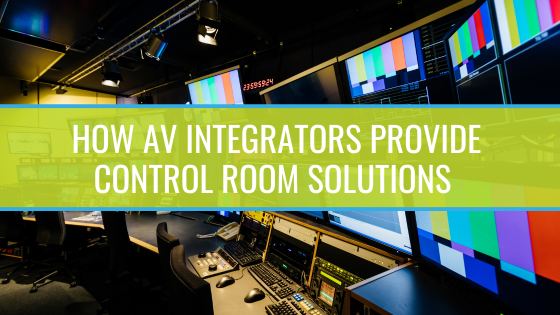What AV Technology is Found in Control Rooms?
Control rooms are kind of like the frontier of AV solutions. No other setting pushes AV quite as hard, given all the solutions involved and the scale at which they are implemented. For example, here are several AV technologies that are common in control room environments:- A massive video wall or direct view LED panel - The majority of control and command rooms rely on large displays to deliver high-level data to everyone in the space. Termed the "backbone," these displays are what you see when you first walk into a command space, and they provide general situational awareness for personnel.
There is no single best display solution for every command room, but standard options include an ultra-thin bezel video wall or a direct view LED wall.
Direct view LED walls are quickly gaining prominence in control rooms for a few reasons. They support UHD video resolution, provide superior brightness and color quality, are seamless, can be scaled or shaped to any degree and are easier to maintain than previous display options. Direct view LED systems are the future of large-scale displays.
- Multiple workstations and display clusters - The backbone is only one part of the system, though. Control rooms house many workstations, each one an interfacing point for in-room personnel. It's common for facilities to dedicate multiple smaller monitors to each workstation, and to attach these monitors to switching technology so operators at each workstation can parse through information quickly.
- Conferencing hardware - Although it's not always necessary, conferencing solutions allow control room managers to communicate with other decision makers in the organization. It can also be used to quickly communicate with field personnel when a situation is developing. Using a dedicated hardware solution ensures better security and offers a layer of redundancy in case other communication options are unavailable.
- AV control systems - Control rooms may have hundreds of AV components in operation at once. Operating all of them in an organized fashion is a must, and AV control solutions make that possible.
On the user's side, AV controls may be hardware switches, such as wall switches. More commonly, though, touchscreens are used for controlling AV equipment. These touchscreens are programmable, vivid, and can be easily integrated into workstations for clutter-free control over in-room hardware. In control and command spaces, there's lots of input and output switching. This can be tied to touchscreen controls, making it simple for operators to cycle through any number of inputs and outputs.
- AV-over-IP deployment - AV-over-IP isn't new, but it's just now catching on in control room applications. With AV-over-IP, AV encoders and decoders are placed at input and output sources. These encoders and decoders can take any input signal - like a surveillance camera - and deliver them to any output source - like a digital display. This is done over the existing IP network, so additional cable doesn't need to be run.
Also, AV-over-IP minimizes intercompatibility issues and greatly improves scalability, as there's almost no limit to the number of devices you can attach to the network when using AV-over-IP. Bandwidth is a concern, though, so this should be done with expert guidance.
With this set of AV tools, facilities can cover all of their information and communication needs.Five Types of Control Rooms Where AV Systems Make Sense
The above AV solutions are appropriate for any control or command space, including:- Network operations centers (NOCs) - NOCs are used by large institutions, like corporate or university campuses, to monitor network performance and status. A lot of display space is needed in NOCs, as operators must monitor network details, any alarms, and a news feed for forecasting potential issues.
- Power plants and utilities - Performance and incident monitoring are also critical for utility and power plant control rooms. Multiple displays are ideal here, for monitoring plant safety, output, and for detecting any field issues, such as a downed transformer or major water leak.
- Municipal services - Municipal services include monitoring transportation networks and emergency responses. Police stations may use their AV displays for dispatch purposes, while a fire department may track incidents and where department assets are deployed.
- Large industrial or warehouse facilities - Control centers are also common in major industrial and warehouse facilities. Here, they can be used for security purposes or for monitoring operations. For example, a warehouse control center may monitor where heavy equipment is deployed or to keep track of where certain goods are stored.
- Call centers - Control rooms are a popular addition to call centers, too, where large displays are used to monitor call load and to route calls to the right workstations.



